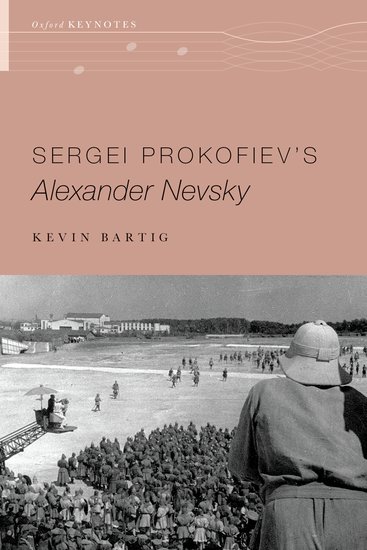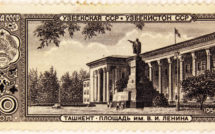
 Particularly within the realm of film, landmarks of creativity are rarely the product of a singular mind. Rather, a great cinematic experience is often the result of artistic collaboration at its finest, as Kevin Bartig demonstrates in his analysis of the classic film Alexander Nevsky (1939). Bartig centers his approach to the work on the mutually fruitful collaboration of two key players: director Sergei Eisenstein and composer Sergei Prokofiev. Through meticulous research and a wealth of contextualization, Bartig traces the film’s history from genesis to reception, illuminating the artistic, social, and bureaucratic phenomena that determined the shape and fate of the film at each stage of development. A succinct and accessible read from Oxford University Press’s Oxford Keynotes series, Sergei Prokofiev’s “Alexander Nevsky” provides a fascinating window into the complex relationships between artists, audiences, and the politics of critical reception.
Particularly within the realm of film, landmarks of creativity are rarely the product of a singular mind. Rather, a great cinematic experience is often the result of artistic collaboration at its finest, as Kevin Bartig demonstrates in his analysis of the classic film Alexander Nevsky (1939). Bartig centers his approach to the work on the mutually fruitful collaboration of two key players: director Sergei Eisenstein and composer Sergei Prokofiev. Through meticulous research and a wealth of contextualization, Bartig traces the film’s history from genesis to reception, illuminating the artistic, social, and bureaucratic phenomena that determined the shape and fate of the film at each stage of development. A succinct and accessible read from Oxford University Press’s Oxford Keynotes series, Sergei Prokofiev’s “Alexander Nevsky” provides a fascinating window into the complex relationships between artists, audiences, and the politics of critical reception.
Bartig begins by untangling the strands of conflict and coaction that beset Soviet artistic production in the 1930s. An uncritical analysis of these circumstances could have resulted in simplistic binaries: a work is either art or propaganda and an artist is either resistant or complicit. By contrast-in examining Eisenstein, Prokofiev, and the inception of Alexander Nevsky-Bartig complicates these categories with the realities of Soviet life. Thus, the oft-discussed history of Soviet censorship proved, in reality, as inconsistent as it was heavy-handed, owing as much to the perceptions and political incentives of key individuals as to ideologies. Moreover, Prokofiev’s artistic struggle was as much a hesitation to compose for film (a “popular” genre as opposed to highbrow concert music) as it was a response to the creative straightjacket of Soviet Realism. His participation in the Nevsky project demonstrates not only his interest in the grand scale of film production, but also his respect for Eisenstein and a desire for the generous compensation that accompanied film composition.
Bartig credits Alexander Nevsky’s success not only to the fine creative work found in the production, but also to the malleability of the film’s content. One of the earliest Soviet films to capitalize on the distant past as a means to develop a usable national history, the story of Alexander Nevsky satisfied both the artistic standards of Eisenstein, Prokofiev, and their team while simultaneously filling Soviet oversight’s appetite for products that were accessible and that forwarded a nationalist agenda. Based on the vague historic tale of a thirteenth-century warrior who single-handedly defeated a rapidly encroaching German offensive, Alexander Nevsky offered a story that was easily sold to a nation trying to reimagine its own historical identity, focusing not on the troubled and familiar recent past, but on the heroism and legend of a lesser-known distant past. Moreover, the historic distance between the Nevsky plot and the film allowed Eisenstein and Prokofiev the liberty to create a past in sight and sound that was dramatic and compelling. Though Bartig found evidence that the production consulted historic research throughout development, he demonstrates the ways in which Eisenstein and Prokofiev used their knowledge of thirteenth-century history and culture to inspire, rather than inform, the film’s visual and sonic landscapes.
Having established the social, political, and artistic contexts in which the film was conceived, Bartig maps its production, including technological experimentation, aesthetic, practical, and bureaucratic challenges encountered, and the often-creative solutions employed. Bartig also provides insightful discussion regarding the ways in which the film was promoted during production and in anticipation of its release. Here, again, the malleability of the film’s content was key to its success. The perils of war and the protagonist’s straightforward heroism made the film marketable to audiences both within Russia and abroad, with Prokofiev’s melodic and cinematic writing clarifying and often driving the action and emotion in Eisenstein’s cinematography. The film was heralded both as a triumph of Soviet Realism within the U.S.S.R. and as an apogee of modern artistic film abroad. Bartig also demonstrates how critical timing was to the film’s reception by situating the story of its production and release within its geopolitical and cultural milieu. The parallels between the German aggression in the film and World War II are particularly well canvassed, highlighting the inseparability of politics, social conditions, creative products, and reception in understanding cultural phenomena.
Bartig’s experience as a scholar of film music and an expert on Prokofiev is clearly conveyed in his analysis of Alexander Nevsky. Though he keeps discussion readily accessible to those without musical training, Bartig examines Prokofiev’s writing with remarkable depth to explain the context of the composer’s musical references as well as the ways in which those references would have been understood by the contemporary listener. For example, Bartig discusses in some detail the famed chorus, “Arise, Ye Russian People,” heard in the movie as Russian troops prepare for battle. Though the text alone could be enough to understand the piece as blatant nationalism, Bartig goes a step further to place the chorus as an intentional reference to Russian composer Alexander Borodin’s well-known final opera, Prince Igor (1888). As the author reveals the historic and sonic connections between Prokofiev’s chorus and Prince Igor, the reader begins to realize not only how and why the film’s music was important, but the ways in which a Russian listener might have heard and understood the score in 1939.
Bartig’s analysis, however, does not conclude with the 1939 film score. He continues to trace the music, focusing next on Prokofiev’s own musical adaptation, a concert cantata for voices and orchestra which was (and still is) a staple of choral-orchestral literature. Here, the author establishes the ways in which the music itself – absent the film’s visuals and dialogue –took on a life of its own. Returning to the contemporary critical debate regarding the validity of film composition as an art form, Bartig argues that the Alexander Nevsky cantata provided music critics with a highbrow piece of concert music worthy of praise, whereas the film score received comparably little critical attention from the same writers. The author draws out Prokofiev’s ability to capitalize on the popularity of the film to promote his concert adaptation, once again illuminating the complex relationship between monetary, artistic, social, and bureaucratic successes in Soviet art. Furthermore, the cantata, like the film, was received in the context of carefully woven narratives that need not necessarily be consistent over the years or across cultural geographies.
The argument presented is certainly from a musicological perspective; Bartig makes little effort to analyze the cinematography with the same care and detail as the score and subsequent musical products. Though Eisenstein is indeed a critical character in the Bartig’s narrative, his focus is centered on Prokofiev throughout. Whereas one might approach the score as a service to the popular film, Bartig approaches the film as one stage in the life of Prokofiev’s music. This tactic offers a fresh perspective that is not unjustified, as the film has dropped into the relative obscurity of classic cinema while the cantata has endured as a mainstay of modern choral-orchestral literature. Though the author largely leaves to the imagination broader conclusions regarding the tenacity of particular Soviet artistic artifacts over others, he does, however, present a compelling case for the ways in which lasting artistic products are reinterpreted over time, allowing them to become newly relevant to modern audiences.
Bartig distills a wealth of research against a backdrop of cultural and political history to unwrap the story of Prokofiev’s Alexander Nevsky with the ease and efficiency afforded by his considerable expertise. Though the music specialist will certainly appreciate his thorough analysis, the average reader will likely find the language clear and cogent. The book is accompanied by a website containing visual and aural examples which further serve to enhance the study Bartig has presented.
Reviewed by Jamie Blake
Sergei Prokoviev’s “Alexander Nevsky”
By Kevin Bartig
Publisher: Oxford University Press
Hardcover / 161 pages / 2017
ISBN: 9780190269562
To read more book reviews, please click here.
Published on June 5, 2018.




